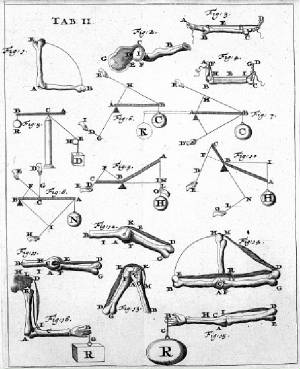JKD Biomechanics LLC
Tao of Biomechanics
|
|
|
Basic Concepts of Biomechanics Biomechanics is the study of the structure and function of biological systems by means of the methods of "mechanics." - which is the branch of physics involving analysis of the actions of forces. Within "mechanics" there are two sub-fields of study: (1) statics, which is the study of systems that are in a state of constant motion either at rest (with no motion) or moving with a constant velocity; and (2) dynamics, which is the study of systems in motion in which acceleration is present. Mechanics (and subsequently Biomechanics) are based on Newton's Laws (also known as Newtonian Mechanics). Biomechanics can be divided into two sub disciplines; 1. Kinematics is the study of the motion of bodies with respect to time, displacement, velocity, and speed of movement either in a straight line or in a rotary direction. 2. Kinetics is the study of the forces associated with motion, including forces causing motion and forces resulting from motion. Biomechanics is sometimes called kinesiology but can be differentiated from it.
BIOMECHANICAL ANALYSES: In general, there are two approaches used to study mechanical aspects of human movement. There is the quantitative approach that involves the use of numbers. This approach helps to eliminate subjective description and relies on data from the use of different equipment and instruments (3D motion analysis systems, force plates, EMG, cinematographic techniques etc. ). The qualitative approach describes movement without the use of numbers. This approach is used a lot in coaching and during the teaching of sports skills. Both quantitative and qualitative descriptions play important roles in the biomechanical analysis of human movement. NEWTONIAN LAWS: Law of Inertia - Newton's 1st Law states that an object continues in a state of rest or of uniform motion in a straight line unless acted upon by an external force. Inertia is Latin for idleness or laziness. The Law of Inertia can be interpreted as everything in the universe is lazy, thus requiring a force to get it on the move (which then occurs in a straight line). Once moving, more force is needed to slow it, stop it, or to speed it up or to change direction. Inertia is the body's resistance to change in movement. It is proportional to mass, thus the mass of an object is the measure of its inertia. Therefore, mass is the quantity of resistance to change. It should not be confused with weight. The weight of a person (or an object) is the measure of force with which the earth pulls on the body's mass. This downward gravitational force is the body's weight directed towards the earth's center. Understandably so, a body's mass and weight are directly proportional. The more mass a body has, the greater the earth's attraction on it, the more it will weigh. Weight is a force; whereas, mass is not. It has no direction. Mass is the resistance to change (i.e., inertia). Law of Acceleration - Newton's 2nd Law states When a body is acted upon by a force, its resulting acceleration is proportional to the force and inversely proportional to the mass. Hence, with a constant mass, the greater the force, the greater the acceleration. And, with a constant force applied, the greater the mass, the less the acceleration. Another way of saying the same thing is: "The velocity of a moving object will remain constant unless a force acts on it." Law of Action and Reaction - Newton's 3rd Law can
be stated as follows: If one body exerts a force on another body, the second body will exert an equal and opposite force
on the first body. Hence, it is sometimes referred to as the principle of action and reaction, which can be stated:
"For every force, there is an equal and opposite reaction force. Essentially, Newton's 3rd Law is a statement that
forces always exist in pairs. For example, when we take a step forward, we press our foot against the floor. Because
of the friction between the foot and the floor, we exert a backward force on the floor. The reaction force is the equal
and opposite force exerted by the floor on our foot. It is this force, which acts in the forward direction, that moves
us in the forward direction.
Enter subhead content here
|
|||||||||||
Enter supporting content here

